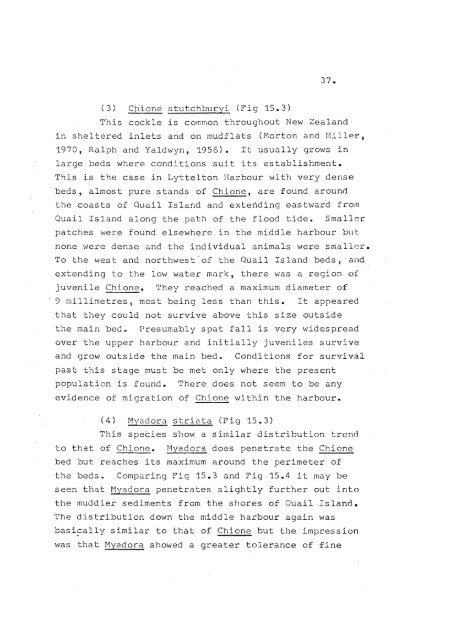The benthic ecology and community structure in Lyttelton Harbour ...
The benthic ecology and community structure in Lyttelton Harbour ...
The benthic ecology and community structure in Lyttelton Harbour ...
You also want an ePaper? Increase the reach of your titles
YUMPU automatically turns print PDFs into web optimized ePapers that Google loves.
37.<br />
(3) Chion~ stutchbutyi (Fig 15.3)<br />
Th cockle common throughout New Zeal<strong>and</strong>"<br />
<strong>in</strong> sheltered <strong>in</strong>lets <strong>and</strong> on mudflats (Morton <strong>and</strong> Miller,<br />
1970, Ralph <strong>and</strong> Yaldwyn, 1956). It usually grows <strong>in</strong><br />
large beds where conditions suit its establishment.<br />
This is the case <strong>in</strong> Lyttelt6n <strong>Harbour</strong> with very dense<br />
beds, almost pure st<strong>and</strong>s of Chione, are found around<br />
the coas ts of Quai I Is l<strong>and</strong> <strong>and</strong> extend <strong>in</strong>g eas twar"d from<br />
Quail Isl<strong>and</strong> along the path of the flood tide. Smaller<br />
patches "Jere found elsewhere <strong>in</strong> the midd 1e harbour but.<br />
none were dense <strong>and</strong> the <strong>in</strong>dividual animals were smaller.<br />
To the west <strong>and</strong> northwest of the Quail Isl<strong>and</strong> beds, <strong>and</strong><br />
extend<strong>in</strong>g to the low water mark, there was a region of<br />
juvenile Chi6ne. <strong>The</strong>y reached a maximum diameter of<br />
. 9 millimetres, most be<strong>in</strong>g less than thi~. It appeared<br />
that they could not survive above this size outside<br />
the ma<strong>in</strong> bed. Presumably spat fall very widespread<br />
over the upper harbour <strong>and</strong> <strong>in</strong>itially juveniles survive<br />
<strong>and</strong> grow outside the ma<strong>in</strong> bed. Conditions for surviv~l<br />
past this stage must be met only where the present<br />
popUlation is found. <strong>The</strong>re does not seem to be any<br />
evidence of migration of Chione with<strong>in</strong> the harbour.<br />
(4) Myadora striata (Fig 15$3)<br />
This species show a similar distribution trend<br />
to that of Chione. Myadbra does penetrate the Chione<br />
bed but reaches its maximum around the perimeter of<br />
the beds. Compar<strong>in</strong>g Fig 15.3 <strong>and</strong> Fig 15.4 it may be<br />
seen that Myadorapenetr~tes slightly further out <strong>in</strong>to<br />
the muddier sediments from the shores of Quail Isl<strong>and</strong>.<br />
<strong>The</strong> distribution down the middle harbour aga<strong>in</strong> was<br />
basi~ally<br />
similar to that of Chione but the impression<br />
was that!::1,ya.dora showed a greater tolerance of ne
















